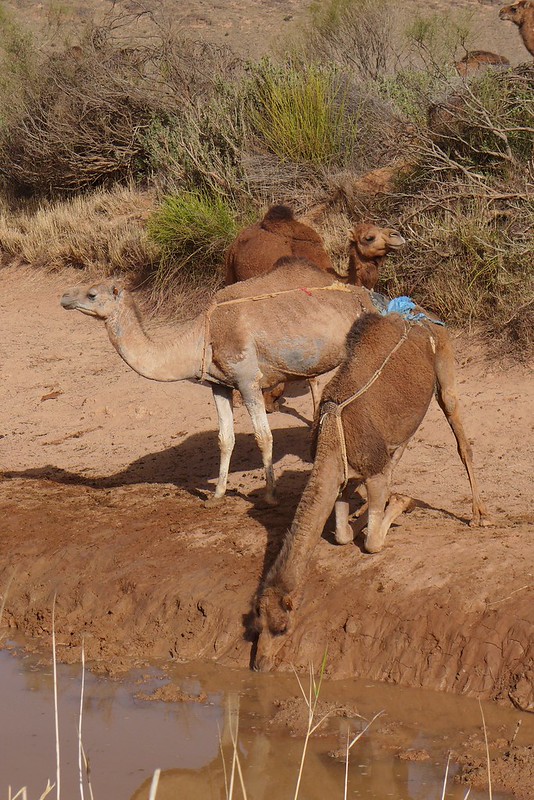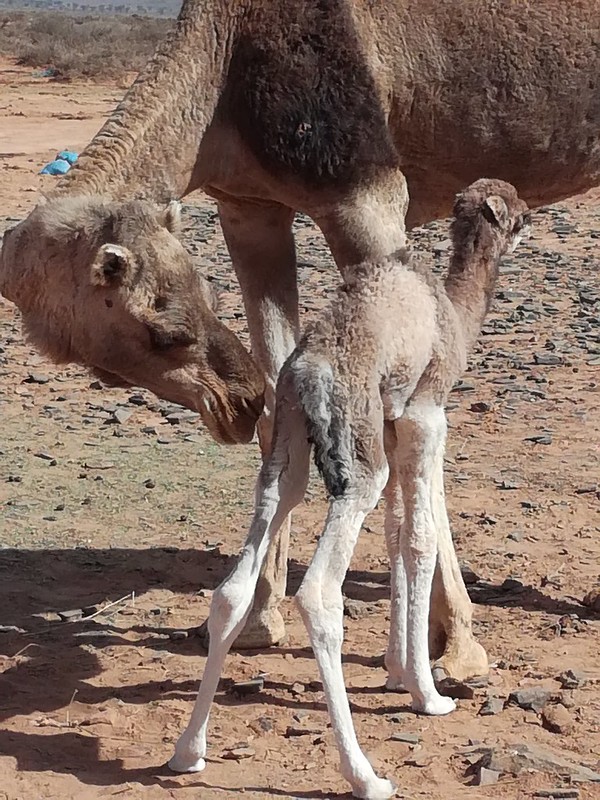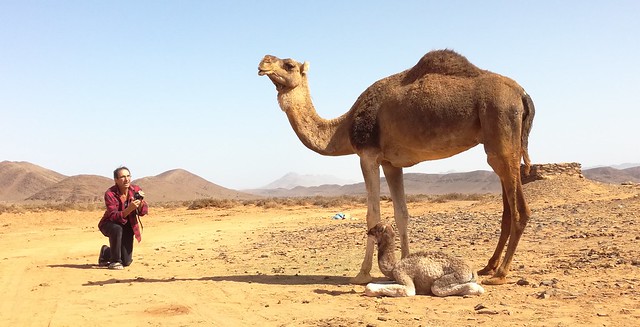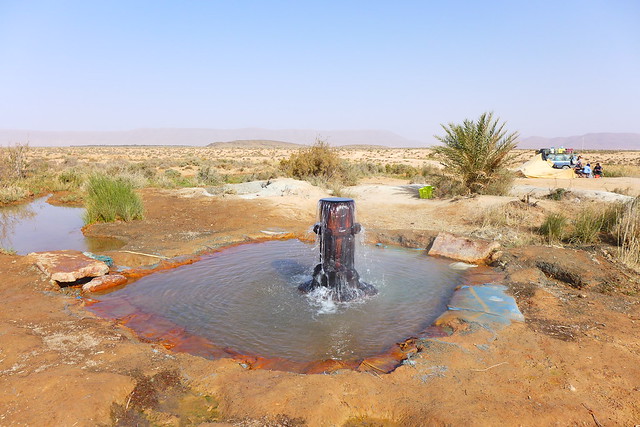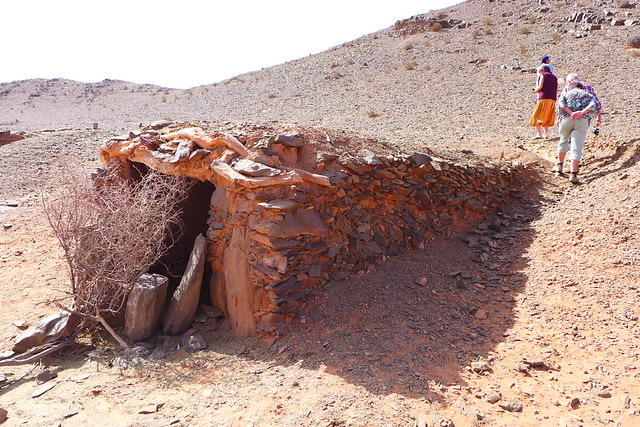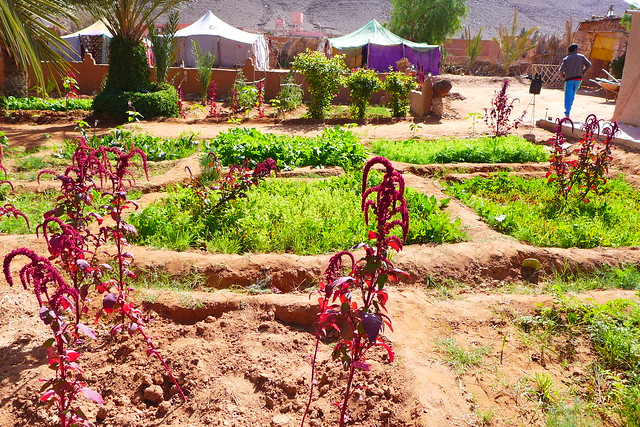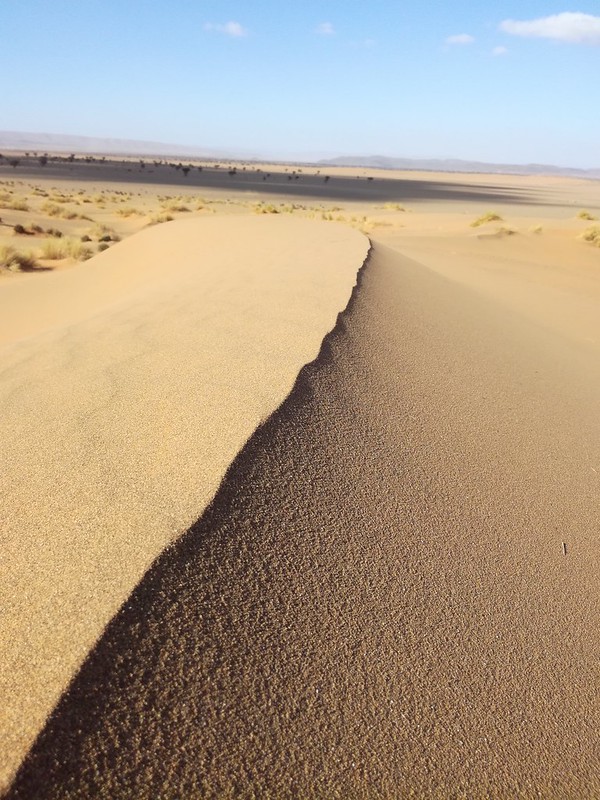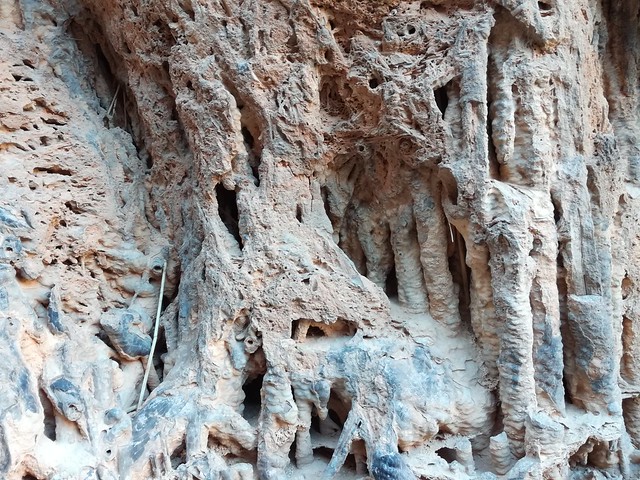On the tourist route for one day
The Moroccans really know a thing about tourism. Almost every campsite offers trips into the surrounding region. So far we have declined them, but Sala’s pitch is convincing, so for once we join the group of people who one morning climb aboard a rickety (but we are assured trusty) Landrover and set off. Ramdan, our 1.5-handed driver quickly shows that he exactly knows the width of his car as he passes walls and donkey carts at a hair’s breadth. Soon we leave the oasis out the back end and rattle off into the desert on paths that are hardly distinguishable as such.
Our first stop is the Oasis’s river. We tumble out of the car to take in just how much lower the river is these days, as we walk across an old dam that was built by the French last century. Sala reminisces about the amount of birds that one could see then. Back into the Landrover and we rumble on for a while. Suddenly Sala says there are the camels! It takes us a while to spot them, they are quite well camouflaged in this landscape of brown tones and bushes. We stop to watch them by a watering hole. Some of them have ‘chastity belts’ on – baby camels quite happily drink from any available adult female, so their udders get covered. When they are milked, a bit is left in for the young ones to drink. Mothers with very young camels get separated from the group so the little one can suckle any time it needs to.
We meet one such very young camel – just a few hours old, it has difficulty getting up onto its long, spindly legs. Several attempts end up in a heap on the floor, but eventually it stands and takes some wobbly steps towards its mother’s udder, gently being nudged by her in that direction.
Frank goes a bit closer to take some photos but is warned off by the deep growl and a sort of blubbery sound the mother makes as she gathers her spittle just in case.
Our next stop is a hot spring. Some company drilled for oil, unsuccessfully, plugged the borehole and left. Some years later, the water, salty and rich in minerals, had corroded the plug and shot out of the standing pipe. Now it has calmed down to a gentle flow and the locals have dug a little basin around it, and at just over 40 degrees it’s like a really hot bath. Frank and I came prepared, so we don our swimming costumes and hop in.
Hot springs can attract strange people, we’ve already seen this in the South of Spain. Here, an English man has taken a kind of guardianship of the spring, frequently ‘cleaning’ it by letting the water out and reshaping the basin, much to the annoyance of other users. Apparently he’s quite a barky type and has had a number of fairly serious clashes with several people, Sala being amongst them. Today he seems quiet, just sitting in his chair and watching the proceedings.
Back in the 4×4 and on to the next site, where we walk around a little mountain that is the focal point for a nomadic tribe. We see some ancient grain stores and hear how the nomads may stay here during the planting season and till, sow, grow and harvest their grains, stash them away in these underground stores, close the entrance with sticks and stones and move camp, leaving their harvest behind. It would be easy to break into one of these stores, but stealing is seen as such a bad activity (and used to be very heavily punished – now it ‘just’ lands people in prison, but previously people would lose a limb) that the food is safe until the family returns.
We pass an old cemetery and Sala tells us that someone (probably a foreigner) dug up one of the graves and found a whole load of treasures. He throws a stone into the middle of the cemetery to mark where the grave was robbed. Again, I muse, how come not more graves are robbed if people know there may well be treasures buried there? Sala shrugs his shoulders. We have a lot of respect for the dead. We don’t even enter a cemetery, let alone think of digging something up.
The picture above shows the cemetery. Small stones for children, large stones for adults. Grouped in two denotes a male, a single stone denotes a female. The building in the background is for someone of high standing in the community. According to Sala, this would be someone who was knowledgeable and contributed to the community through sharing his knowledge.
Our next stop is lunch with Hassan, a nomad who grows organic vegetables in his compound in a little village called Tadalt. This garden is a little paradise, so green and luscious in the middle of an arid landscape. Apparently, water is quite easily available at about 5 meters depth. There are a couple of buildings, one for the kitchen and one for the toilets, but apart from that, there are tents and a lot of open space to grow vegetables. It seems that for a Nomad, houses are for storing food but not to live in.
Those red plants in the foreground are aptly named Turkey’s noses!
We are served a delicious couscous with vegetables from the garden before a local guide takes us for a walk around the village. It looks quite deserted, but we are told it used to be thriving, with about 500 inhabitants. Then one day in the 1980ies, King Hassan II decided to relocate the whole village to Layoune, some 800km away – he needed people to populate disputed territory near the Algerian border. The military arrived unannounced and loaded everyone into buses. About 20% of the population managed to hide with their livestock in the mountains when the military came, and they still inhabit the otherwise deserted village. Why did the people not try to get back from Layoune? I wonder. They were offered everything there, good houses with water and electricity, education for their children, good health care etc. In the end, it didn’t matter too much to them where they lived, as long as they were well. Once the children were in school and a planting season had got under way, people were more likely to stay. But families got split? Yes, my brother lives in Layoune, I haven’t seen him since he left.
Our guide seems to have picked out Frank and me as the ones who might be gullible or crazy enough to buy his family’s 500 year-old tumble down Kasbah, or what remains of it, to be precise. I’d say he has a good eye; out of our group, we probably are the ones most vulnerable to this idea. So he tries to tempt us by showing us how the Nomads used to hide treasures by incorporating clay vessels into the walls of houses. He points out some of the hidey-holes and hints at many other potential places. He tells us that some Italians bought a Kasbah in the village, purely to hunt for treasure, found lots and then left again. And, I think just in case we are crazy enough to maybe even consider living here, he points out two wells, one at each end of the property. Paperwork is easy, he says, just a bit of Bakshish and the thing is yours. It’s practically a gift!
When we get back to Hassan’s, Sala has woken from his siesta and together, we head off to our next destination, a few sand dunes snuggling in between two black mountain ranges. It’s not the same, going to a place like this with a group of people, as when I’m on my own – I don’t get the same feeling of peace and quiet – nevertheless, I manage to break away and capture some more beautiful photos of the play of sand, wind, light and shadow. I love how the wind creates such a sharp line of sand on the top of the dune.
It is quite windy today – on the next bit of road, we see great clouds of sand passing and there are times when the car starts to skid as if on ice as it travels across sand-covered bits of road. Soon, we turn off the road once more as we take off up the hill. Ramdan expertly chooses his way amongst a myriad of possible paths, to get us to a series of cascades just as the sun nears the horizon. We take a bit of time to walk around in this extraordinary canyon. There are some strange rock formations, they look like fossilised roots and plants –
Our last stop of the day is a kasbah that has been turned into a museum. A large and jovial Berber awaits us. There’s no electricity in the kasbah, so we all turn on our mobile torches to view an eclectic collection of household items, furniture, clothing, agricultural tools etc. Explanations are punctuated by appreciative hollering and clicking sounds from the guide himself. In the last light of the day, we are shown into Berber tent in the courtyard where a whole lot of jewellery is for sale. Now it’s up to us to make some appreciative sounds but without necessarily indicating the wish to buy.
When we return to the campsite, we are well tired, but what a day it’s been!
That night, I wake up to the most unusual sound of rain drumming on our roof!
************************
For LOTS more photos of this chapter, including so many cute baby camel photos, click here
Posted in Uncategorizedwith comments disabled.
